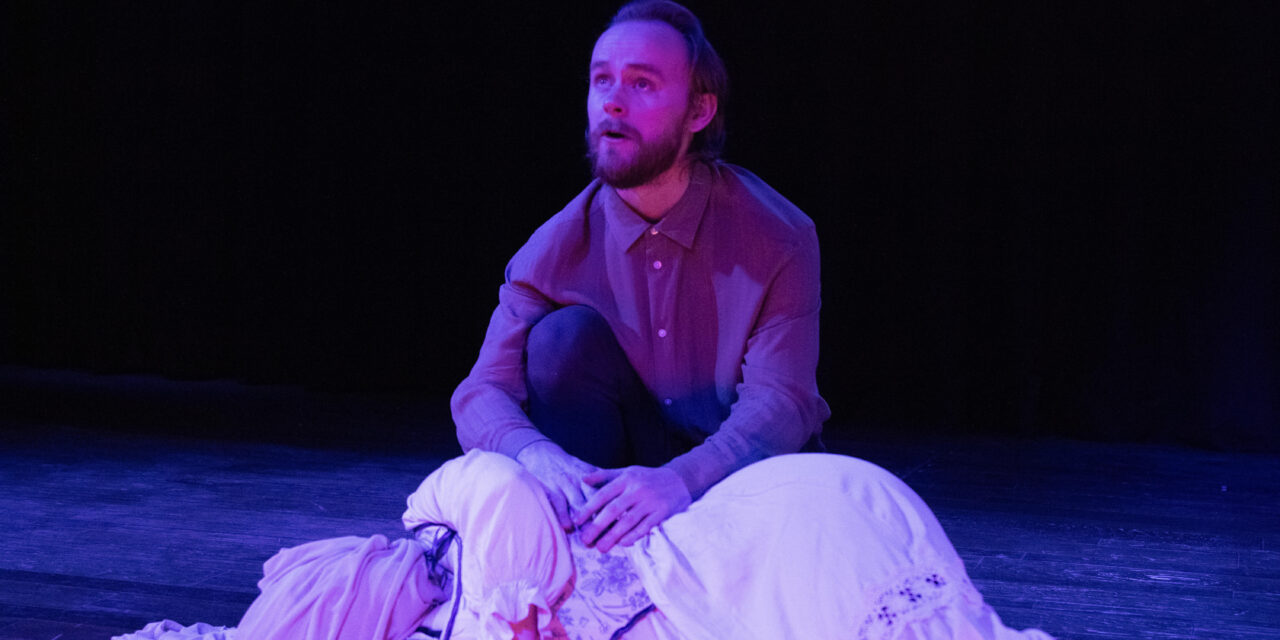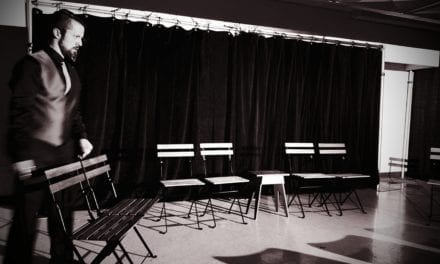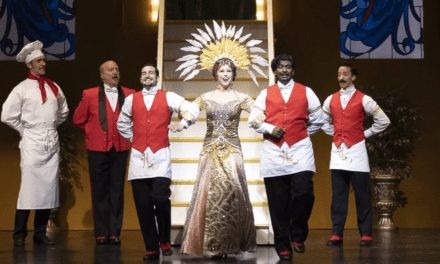PROVO — The Duchess of Malfi is quite the text to tackle, but director Dylan Hamilton Wright rose to the challenge. The Hive Collaborative is a local performing space with intimate staging that perfectly complemented Wright’s vision.
The Duchess of Malfi follows the recently widowed Duchess who is charged by her brothers, Ferdinand and the Cardinal, to never remarry after her husband’s death. The Duchess disobeys and secretly marries her steward, Antonio, inciting the brothers to inflict justice and resulting in deadly consequences for everyone involved. The tragedy tackles themes of corruption, status, and the objectification of women with rich characters both male and female.
This production’s greatest strength was its blend of tradition and modernity. Just like theatrical performances long ago, candles lined the edge of the stage as the primary light source. As the audience prepared for the show, the cast entered the stage with burning candles and lit the scene. Once the line of candles was aglow, the cast remained onstage. The intimate space filled with energy as the cast began to hum in harmony. For the next ten minutes, the cast moved around the stage as one unit, each with a flickering individual candle, singing a haunting melody to set the scene.
This immediately drew me in as an audience member, especially only a foot away from the actors with my front row seating. When the play began, I was already mesmerized by this traditional approach to acting.
Casting women in male roles was a genius decision on Wright’s part. Jeanelle Huff is cold and calculating as the Cardinal, and her chemistry with Edwards’ Julia is impossible to ignore. Susannah Castleton’s Delio has excellent rapport with Kristian Huff’s Antonio, and rose to the challenge of being the sole survivor of the tragedy. The final tableau of Castleton standing before a stage full of bodies is heart-wrenching, and Castleton’s performance is to thank for that chilling moment.
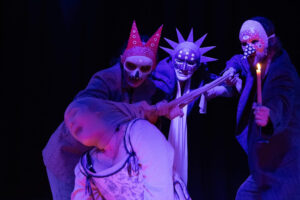
Whispering Room Theatre’s The Duchess of Malfi Plays at The Hive through 11/23. | PC: Dylan Call.
Every actor’s performance was breathtaking as they brought John Webster’s compelling characters to life. Major and minor characters alike shined in their respective roles— Bo Chester’s Cariola held her own next to Clara Wright’s Duchess in both humorous and emotional moments. I was also particularly impressed by Miriam Edwards’ performances as Julia and Pescara; her characters have limited stage time but Edwards’ passion for the story creates a magnetic stage presence with only a few lines of dialogue.
The standout performance of the night, for me, was Sten Shearer’s Ferdinand. Shearer toes the line of intensity and insanity, finally shattering in the final act as Ferdinand suffer from Lycanthropia (believing one is a wolf). Shearer tackles Ferdinand’s gradual decline with enough subtlety to keep the shock factor of Ferdinand’s act five insanity. He leaves everything out on the stage as he crawls around like a dog in nothing but a pair of shorts. Ferdinand’s monologues are rich and complex, but Shearer drew me in with every word — even the ones I couldn’t understand. Again, being in the front row made this twice as intense.
What made this production so unique was the bare bones staging. Whispering Room Theatre’s official concept promotes a stripped-down technical design to focus on the acting. The set design was an intentional lack of set pieces. The only lighting in the show was by legitimate candlelight both from the candles downstage and by the candles in the actors’ hands; yes, real fire on real candles near curtains, clothing, and hair. I have to applaud the fire safety of everyone involved as I was genuinely concerned every time someone walked through the curtains with an open flame or died beside a lit candle. The candlelight created a perfect haunting atmosphere for the production and added unique symbolism for every candle that was extinguished through the play.
The stage was empty at the start of the play save the candles, a guitar, a mandolin, and three clothing hangers with infant clothing. Kristian Huff played the guitar in scenes as Antonio, even dueting with C. Wright’s Duchess on the mandolin during romantic scenes. However, K. Huff also appeared onstage to play the guitar in scenes his character wasn’t originally in; I believe this was intentional to show Antonio’s lingering presence and create ambiance for the scene. It worked very well.
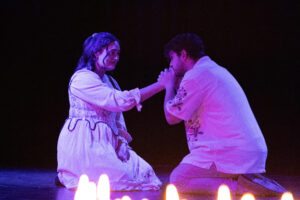
Photo Credit: Dylan Call
Why the hangers, you ask? The Duchess and Antonio secretly birth three children. Rather than use actors, Wright chose to represent the children with clothing. C. Wright, Chester, and K. Huff sell the portrayal, gently handling and rocking the objects as if they are children. The eldest son is depicted as the eldest with his hanger being a child’s outfit; the actors hold the hanger to their side as if they are helping a child walk beside them. I appreciated the innocence of the clothing and creativity for the eldest son. When the Duchess is murdered with Cariola and her two youngest children, the “dead bodies” are the pieces of clothing lying on the floor. Wright creates a horrific tableau without actual children. The scene is still graphic thanks to the chilling fight choreography without the children being actively strangled onstage.
Speaking of fight choreography, each fight is realistic and intense. The Duchess and Cariola are both strangled; Cariola struggles against her murderer, done stunning by Chester. The Cardinal, Ferdinand, and Bosola have a three-way sword fight in the final scene that amplifies the clear stakes in place for a thrilling conclusion to the show. It is clear that great care was put into the fight choreography by highly qualified professionals.
As for the costume design, I liked the modern touch. If an actress was portraying a man, she wore pants to distinguish her from actresses playing women. One small detail that went a long way for me was removing the Duchess’s corset when she is pregnant with her eldest child; Bosola comments on her clothes not fitting to support his theory that she is great with child. Additionally, the use of masks was creative. Varying mask colors were used for the officers and executioners, creating an abstract but traditional feel.
Overall, Whispering Room Theatre’s The Duchess of Malfi was a masterful homage to traditional theater, with its stripped-down design and raw performances. Every actor brought depth and passion to their roles, creating a truly captivating experience. This production was a chilling reminder of the enduring power of classical tragedy, and I eagerly anticipate the company’s future work.

